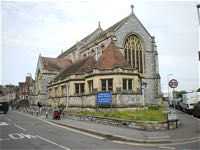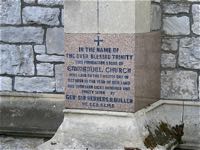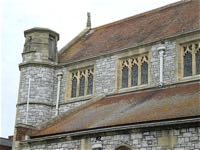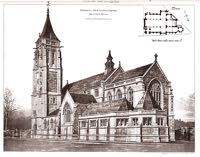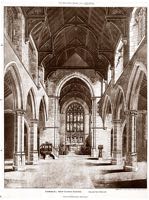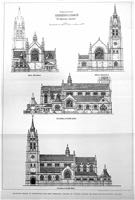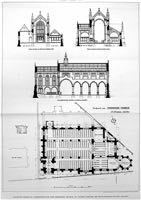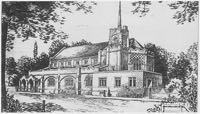
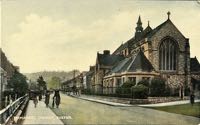 Emmanuel Church, Okehampton Road
Emmanuel Church, Okehampton Road
Page updated 14th February 2018
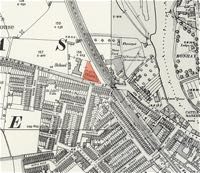 In 1908, Edith Cresswell wrote in her book, Exeter Churches, of Emmanuel Church, “Of a church so new there is little to be said, for whatever is done can but be a beginning, earnest of further work to come.” The newest church in the city at the time of writing, she was not overly impressed, by the poor quality of the paintings of saints and prophets behind the altar in the south chancel.
In 1908, Edith Cresswell wrote in her book, Exeter Churches, of Emmanuel Church, “Of a church so new there is little to be said, for whatever is done can but be a beginning, earnest of further work to come.” The newest church in the city at the time of writing, she was not overly impressed, by the poor quality of the paintings of saints and prophets behind the altar in the south chancel.
The Iron Church
St Thomas Church, in Cowick Street, seated 600, while the parish contained 6,600 people. There was clearly a need for a new church so the area within Cowick Street, Buddle Lane, and Exwick Road, and the boundary of Exwick Parish, was defined, with an estimated population of 2,500 people for a new church.
The original Emmanuel Church was an iron structure constructed in 1887 at a cost of £279 10s. It was the third church (other than Alphington) west of the river, with St Thomas and St Andrews preceding it. The iron church was built on land donated by Sir Redvers Buller, on the corner of Okehampton Road and the path that led to Exwick, just west of the railway line.
Stone replaces iron
However, it was obvious that the ‘tin church’ would not be adequate for long, and in 1892 a committee was set up to discuss the construction of a permanent structure. An advert was put out for a nation wide competition to design the new church. By 1895, fundraising had started. There were 119 designs submitted for the church, many of which included towers. The chosen design was by Mr. Harold Brakespear, A.R.I.B.A of Corsham, Wilts. It was built at a cost of £7,088 by Messrs N Pratt & Son of Clyst St Mary.
On 12 October 1897, General Sir Redvers Buller laid the foundation stone for the church, which was to be built on the same plot as the old iron church. Beneath the stone there was placed a box containing copies of the day’s newspapers and coins of the realm.
The design was in the early Perpendicular style with the exterior of grey Babbacombe limestone with a tiled roof. Within, the walls are lined with red stone, and there are freestone pillars between the four bays of the nave with sculptured capitals. The windows are in Bath stone.
The interior consists of nave, north and south aisles, north and south transepts, and a chancel and seating for 600 people. The nave has clerestory windows, and a wagon roof. The entrance is by a south door. The font is large, octagonal, of freestone and red marble; there is a carved oak pulpit. The transepts are separated from the nave by arches, and there is a somewhat narrow chancel arch. There are also chancel aisles the south one being furnished as an additional chapel, with a second altar. Here the walls, and the panels on the front of the altar are painted with figures of Saints and Prophets. Behind the altar in the chancel are paintings of Seraphim, evidently done by the same hand. The sanctuary floor is tile; on the north side is a credence ( a small table), on the south sedilia (stone seating). The building was originally illuminated by gas, but was replaced by electricity in May 1929.
The church was opened on St Andrew’s day, the 30 November 1899, at a 3pm service, with the Mayor and members of the Corporation present. The dedication was given by the Bishop of Exeter. A separate service of consecration was given on 2 October 1900, when the Archbishop of Canterbury was invited to preach.
Opened as a District Church, it became a Parish Church on the 29 April 1910 when the Rev. C H Williams was appointed the first vicar.
In 1924 a memorial window was unveiled in memory of Capt. R F Scott who led the unsuccessful attempt to reach the South Pole in 1912, by his second in command Capt. Edward Evans RN. The window was damaged in 1942 by a bomb and restored in 1948. The bomb also damaged the roof of the church, leaving the building unusable until it was repaired in March 1943.
The 1960 floods
During the floods of October and December 1960, the flooring and furnishing were badly damaged as water flowed past and through the church. During the flooding two young boys, Dave Bucknell and Terry Roberts were trapped in the church. Dave who was a choir boy at the church explained:
“When we tried to leave at 4pm the water had risen outside and we were trapped. We hoped it would go down but it didn’t and when four or more feet of it got into the church, we went and sat on the window ledge in the Lady Chapel, where we pretended to be shipwrecked sailors.
“We were still there at midnight, but then a very brave policeman managed to rescue us. He climbed along the backs of other buildings, tying ropes to downspouts, to get to us, and led us back to safety the same way he had come.”
Police Sgt Leyman was helped by the then Deputy Chief Constable of Exeter, Supt Joe Pessell, and PC Peter Grimes along with Exeter fireman Ivor Hatton to lead the boys through the flood waters.
The Exeter floods were filmed by the BBC at the time; their cameras went into the church after the flood waters subsided, and show the damage to the parquet flooring–hundreds of wooden floor blocks have been dislodged from the floor and are being stacked by choir boys in the aisles. Some pews were also dislodged in the flood, while 75% of the floor had to be replaced.
All three churches in St Thomas faced bills for essential repairs including St Thomas Church, which required £3 million to be spent for essential repairs. The parish was forced to consider the future of St Thomas, Emmanuel and St Andrew’s Church (Alphington Road). It was apparent that the parish was over provided with churches and the decision was made to close Emmanuel Church in October 2014. Rector Nick Edwards said it was better to close Emmanuel rather than try to keep up with the maintenance costs. Tentative plans were made to allow the Riverside Church, based in Okehampton Street to use the building, but in 2016, the church is still empty.
The Church Hall
The first church hall was the King’s Hall in Okehampton Street which was sold in 1922. A replacement was constructed in Emmanuel Road. This became a social hub for the area, and was one of the few halls in the city suitable for hosting dances. During the Second War, Borough Polytechnic from London was evacuated to Exeter and given the church hall for its use. The hall eventually became unviable and it closed in 1976, to be sold to the Northcott Theatre for use as a rehearsal room, and performance space, where small productions and touring theatre groups would perform. The financial difficulties suffered by the Northcott has seen the hall empty for the last few years.
Sources: Express and Echo, British Newspaper Archive, History of Emmanuel Church (a leaflet published by the church).
│ Top of Page │
